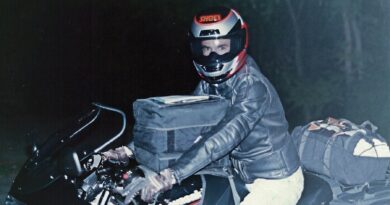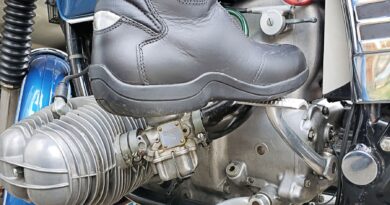Once in a while
As Colonel John “Hannibal” Smith was fond of saying about The A-Team’s crime-fighting successes, “I love it when a plan comes together.” Usually that’s not at all what happens in my life as a motorcyclist. Whether in the saddle or garage, Murphy’s law reigns supreme. Buddies’ schedules change at the last minute, machinery malfunctions at the worst possible moments, routes require elaborate detours, and weather defies even the most recent forecasting. Farkles don’t fit or function as advertised, repairing one thing reveals the need to repair another, and a workshop packed full of tools, fasteners, and supplies still lacks one element necessary for the mechanical operation underway (especially when hurriedly prepping for a ride the next morning). Unexpected snags and challenges are just part of the adventure, and require determination, resourcefulness, and flexibility in the routine activities of our beloved avocation. This makes it quite remarkable when things run smoothly as intended or include only minor bumps in the road.
 I’ve made the argument here before that rides and projects containing frightful disruptions and demanding exotic problem-solving make the best stories, whether enjoyed (after they’re over, of course!) in conversation or private reverie. A trip or repair that simply unfolds as expected can seem blandly unmemorable by comparison, even though such a placid outcome is our default wish. It’s the extraordinary drama that remains vivid and indelible—maybe even accruing “enhancements”—over time. Human memory seems to have an innate bias in this regard, with negative events given a certain priority in our recall. This has survival value, since it’s more important to remember where we stumbled upon the bear than where we found the honey. Another encounter with the former may well immediately preclude the possibility of ever seeking the latter again, whereas we’ll probably find something else to eat before starving, even if it’s not as sweet.
I’ve made the argument here before that rides and projects containing frightful disruptions and demanding exotic problem-solving make the best stories, whether enjoyed (after they’re over, of course!) in conversation or private reverie. A trip or repair that simply unfolds as expected can seem blandly unmemorable by comparison, even though such a placid outcome is our default wish. It’s the extraordinary drama that remains vivid and indelible—maybe even accruing “enhancements”—over time. Human memory seems to have an innate bias in this regard, with negative events given a certain priority in our recall. This has survival value, since it’s more important to remember where we stumbled upon the bear than where we found the honey. Another encounter with the former may well immediately preclude the possibility of ever seeking the latter again, whereas we’ll probably find something else to eat before starving, even if it’s not as sweet.
These factors create predictable distortions in our view of the world. If I have to wait at a particular railroad crossing a few times when I’m in a hurry to get somewhere, those frustrations will seem more prevalent than they really are. Maybe it’s something I must endure on only one out of every ten trips through that location. During the nine times I whiz by undeterred, I don’t even register my good fortune, but the next time I have to stop I’ll feel deeply aggrieved: What—this AGAIN?!! How does the @#$& train always know exactly when to intercept me?! It can feel as though, uncannily against all odds, I’m plagued by this annoyance most every time, when in fact it’s a pretty scarce event, just as the odds would predict.
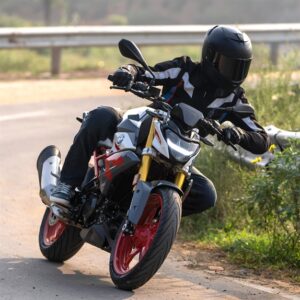
Rather than indulge my sense of persecution by ignoring when things do run smoothly, I’m going to take this opportunity to savor a simple pleasure, an example of a small project that not only didn’t involve any expensive, time-consuming, mind-boggling, gut-churning surprises, but actually turned out nicer and easier than anticipated.
The mercury has begun to fall where I live, and my latest moto-acquisition—a little G 310 R I’ve described previously in this column—is the only bike in my current collection without heated grips. Such warmth augmentation will be especially appreciated on this completely naked machine, and it’s a simple, straightforward modification I’ve performed on many other bikes in the past. Then again, I can’t count the times I’ve set out to do a familiar “simple, straightforward” procedure, only to have it become terribly convoluted and confounding once I got into the new iteration, with special tools required, broken, missing, or ill-fitting parts discovered, or instructions impossible to implement as written. “This will only take a short while,” are famous last words in my garage.
The Ride Inside with Mark Barnes is brought to you by the MOA Foundation. You can join the BMW Motorcycle Owners of America quickly and easily to better take advantage of the Paul B Grant program mentioned in this episode.
Replacement of the old stock grips had been done promptly upon acquiring the bike, as I’m a firm believer the absolute best value in all of motorcycling is a fresh pair of Pro Grip’s #699 Gel Grips—a vast improvement over any OEM street grips, and available for under ten bucks. A little pressurized air beneath the 699s liberated them from their perches, and the plastic throttle tube’s numerous ridges were neatly ground away with my Dremel tool—a tedious, but meditatively satisfying operation necessary for mounting the right-side adhesive-backed heating element. Without such a plastic tube of its own, the clutch-side handlebar was treated to a sheath of thick shrink-wrap to create a balanced level of insulation between each element and the heat-sucking metal bar beneath it. Both sides looked quite neat and tidy after these ministrations, and the elements were wrapped into place without a hitch. Some isopropyl alcohol made the interior of each grip momentarily slippery, and both slid on fuss-free. Safety wire secured the grips with no need for glue, and the heating element wires ran directly into crevices in the headlight nacelle, wherein an OEM switched power source awaited conveniently.
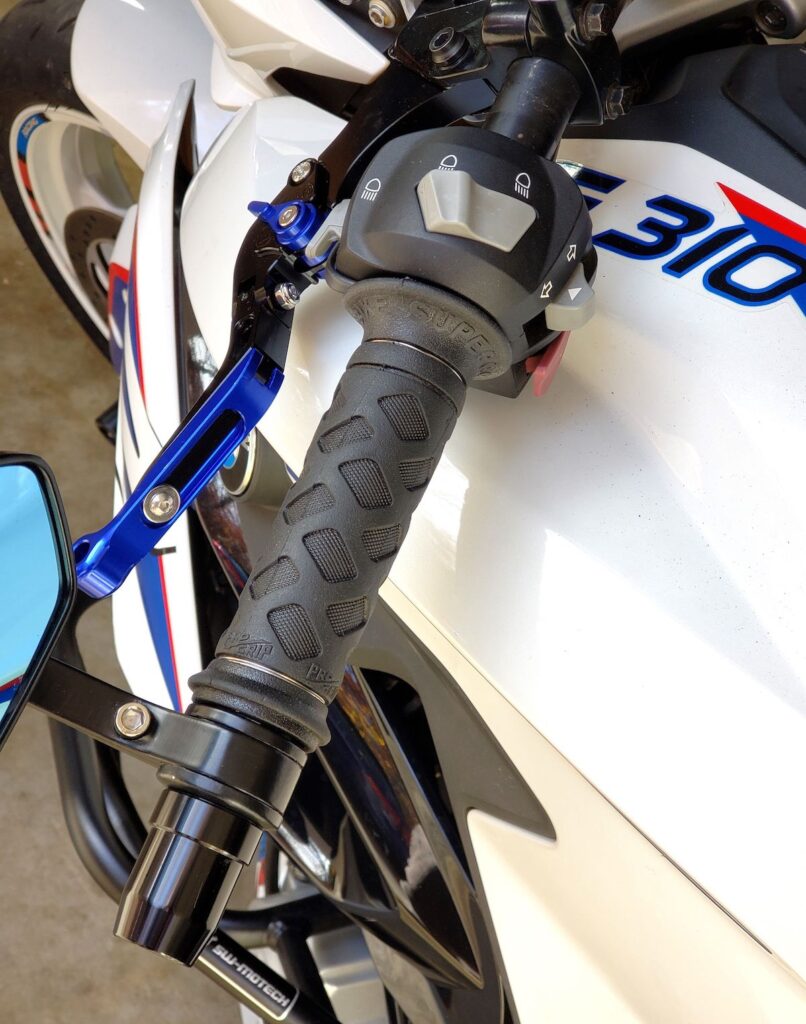
I had assumed the factory-supplied accessory outlet would have some type of generic plug I could readily match. Silly me, this is a BMW we’re talking about here! Instead of being a problem, the special outlet I uncovered was an opportunity to make my setup extra-sano. I could have just snipped off the proprietary plug and spliced the heating element wiring to the remaining power and ground wires, but I found a mate for the fancy receptacle for a few bucks on eBay, and it traveled to my home while I was away for a long weekend. When I returned, the new piece fit perfectly and, when connected to the heating elements, made them literally plug-and-play. But wait, it gets even better!
I still had to mount the controller for my new grip heaters somewhere, and there’s precious little real estate to work with in the 310’s diminutive cockpit. I had thought I’d have to locate the switch on one of the recessed, forward-facing (black) panels of the bodywork around the fuel tank—not ideal for viewing its settings from the riding position, but possibly the only place close to the bars where there’d be enough room underneath for the switch’s lower housing and bulky connectors. This location would also require running the wires out the rear of the nacelle and under the bodywork near the headstock, which might look sloppy. But then I spied a tiny flat spot atop the headlight shroud barely wide enough to accommodate the switch’s diameter. It was level, in plain sight, and adjacent to the instrument panel—exactly where I’d put it if I had to incorporate it into the bike’s design. Was there enough room underneath for the switch’s subterranean parts? Although tightly crowded, yes there was! All I had to do was remove a crescent of material from a flange on another plastic panel that intruded slightly into that cavity; 30 seconds of Dremel work and the space was ideal. I drilled the hole for the switch, snapped it into place, and completed the electrical connections. Reassembly was absurdly thrilling!
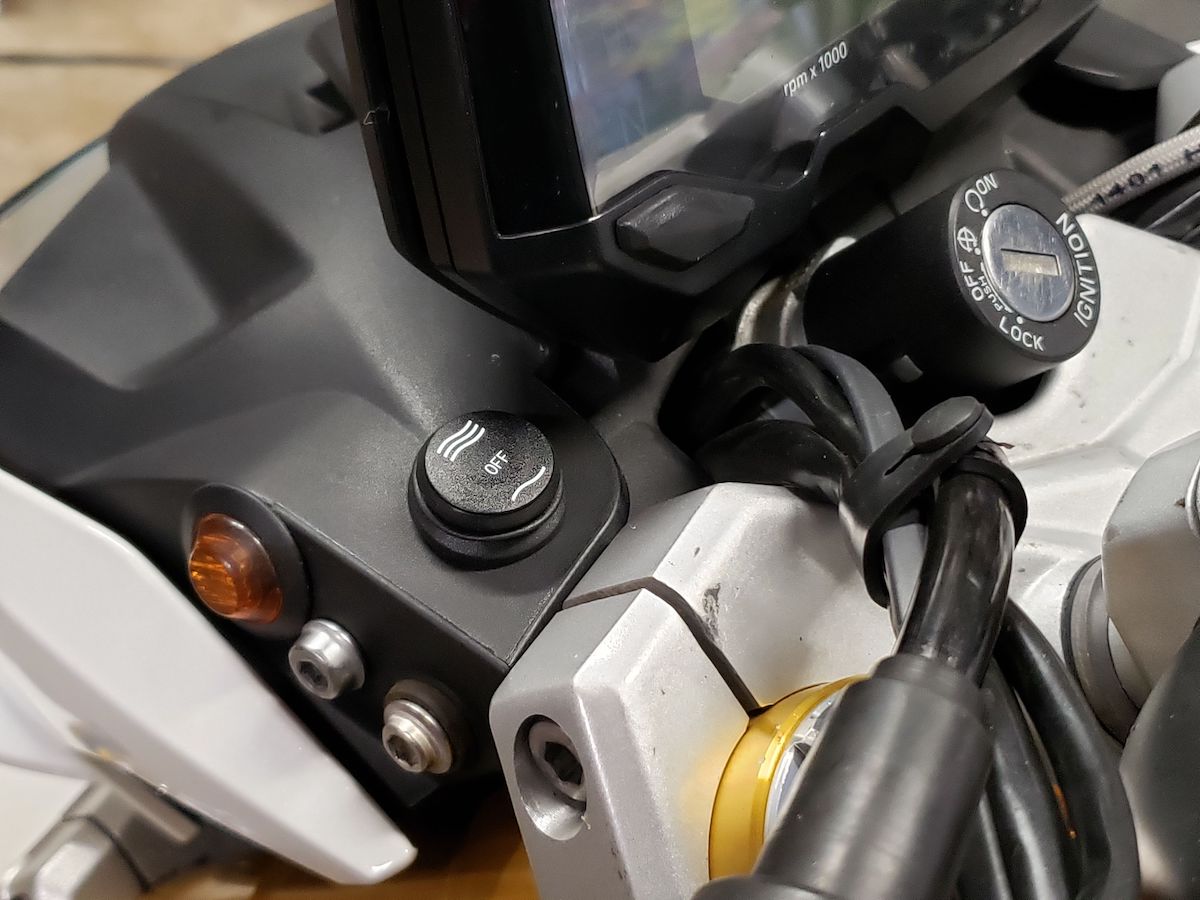
Now, obviously this installation did not represent some magnificent crowning achievement in the realm of motorcycle accessorizing. It was hardly remarkable at all, except for how wonderfully all the parts and procedures fell into place with no curses uttered, no late hours of struggling sacrificed, and no costly mistakes made. Instead of my usual experience of yet again learning a presumed one-hour task actually takes five hours to accomplish, I had sailed through this project faster than expected, and with better results than I’d imagined possible. The finished product looks thoroughly professional, and the switch is much less obtrusive and clunky than BMW’s own controller for this bike’s optional OEM heated grips (which cost many times what I paid for this mod and wouldn’t be nearly as comfy as my trusty 699s). If you’re curious, I used Symtec’s Heat Demon grip heaters with the plastic rocker switch option—around $62 from online vendors. You’ll have to add your own grips and decide whether to buy the accessory outlet plug, but the total will still be a fraction of the $349 BMW wants for their setup.
Every once in a while a plan actually does come together, and that’s a miracle worth loving. It’s important to take note of such rarities so we don’t get too deeply mired in cynicism or self-pity. My little victory doesn’t make for exciting storytelling, and I didn’t learn any new skills or strategies for overcoming adversity in the process, but I felt a pleasant glow throughout the following day and still smile every time I look at that beautifully mounted switch. I’ll be sure to take breaks and gaze at it during the unplanned, chaotic, bewildering, infuriating, and demoralizing trials and tribulations of my next wrenching adventure, deliberately reminding myself better days have made surprise appearances in the past—and may yet pop up again.
Mark Barnes is a clinical psychologist and motojournalist. To read more of his writings, check out his book Why We Ride: A Psychologist Explains the Motorcyclist’s Mind and the Love Affair Between Rider, Bike and Road, currently available in paperback through Amazon and other retailers.



